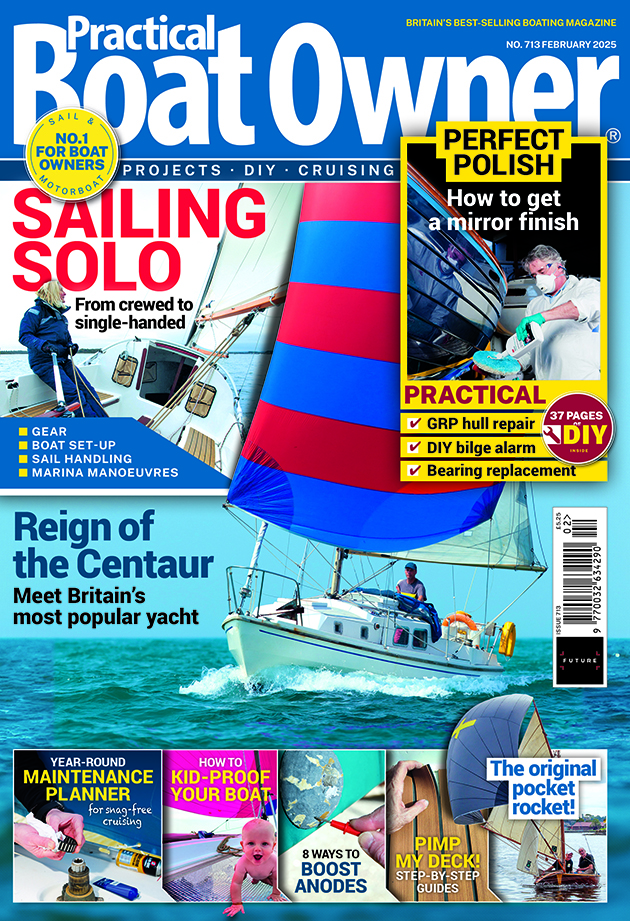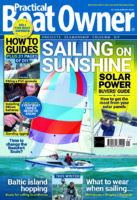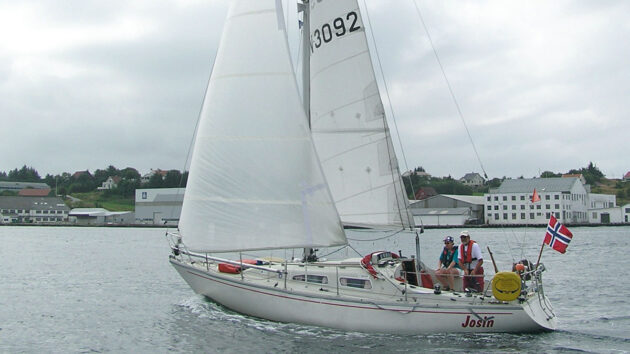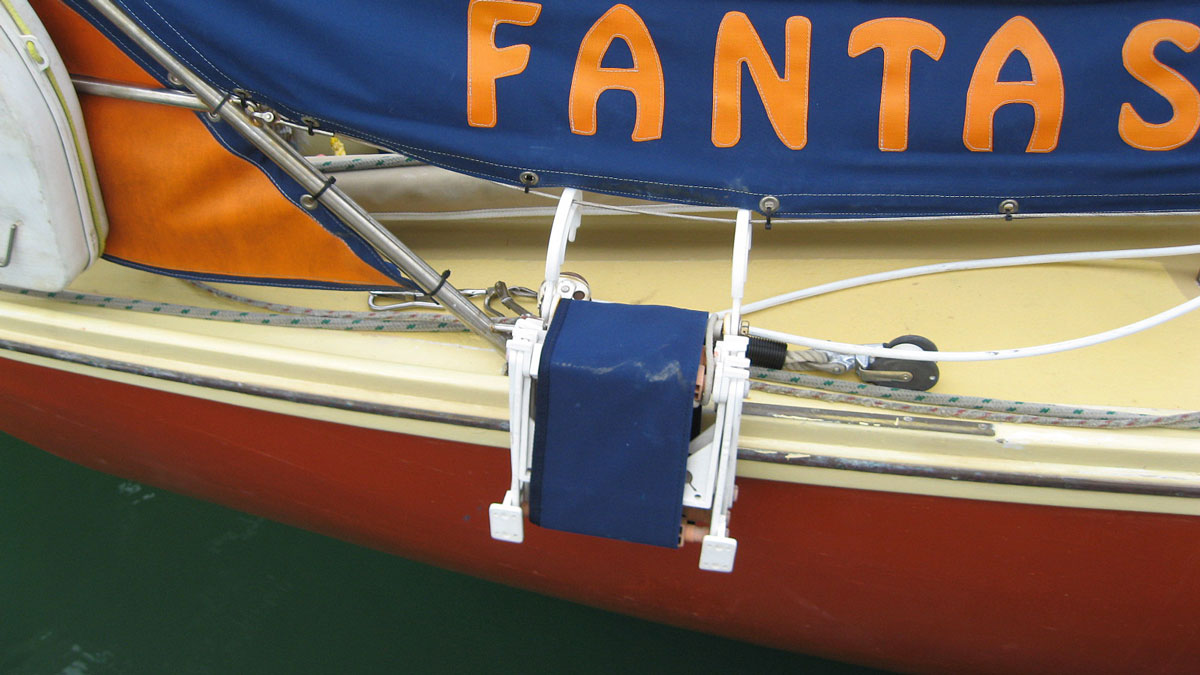John Cotton describes the modifications he has made to his Albin Ballad to make her a safe and dependable yacht for Nordic single-handing
As a solo sailor, I find my Albin Ballad, Josin to be an ideal boat for the purpose.
She is seaworthy, strong, safe, easy to handle and with excellent, predictable sailing characteristics.
Over the last 50 years of cruising boat design, a priority has been placed upon improving space, comfort and facilities: when Josin comes into a harbour she’s accordingly surrounded or squeezed out by much larger, more modern boats.
These have a higher potential cruising speed, so they can get to the next harbour first and occupy the best spots.
There’s not much I can do about that – but during nearly 30 years of sailing in Josin, I’ve carried out a number of adaptations which have at least made her into a safer and more comfortable boat in which to sail single-handed.
The first safety rule for a solo sailor is, of course, not to fall overboard.
The odds against being spotted and rescued are not good, and in the cold, Nordic waters I sail in, survival time is short – so to begin with, appropriate clothing needs to be worn.
It’s always a good idea to wear more clothing than you may think necessary: it’s much easier to remove a layer than to put one on, and it must be borne in mind that body cooling by degrees leads to an insidious and gradual reduction in acuity.
Thin, industrial goatskin gloves are also recommended, both for better grip and first defence against cold fingers.
And of course, it goes without saying that an automatic lifejacket should always be worn, one with crotch straps and a becket for lifting and clipping-on.
Safety lines

Credit: John Cotton
These are snap-hooked onto strong eyebolts low down in the cockpit, and are short enough to ensure that you can’t hang outside the railing.
Safety Hoop

Credit: John Cotton

Credit: John Cotton
Josin has a safety hoop over the cockpit, formed in such a way that if you are under it or behind it, the boom cannot strike you.
It consists of double, curved tubing with a space between: the end of the boom rests on the forward tube, the aft one being a safe, non-finger-pinching handhold. The sides are ranged forward to make them easier to hold onto when going forward.

Credit: John Cotton
This has been enlarged, with larger, more vertical windows for better vision, and has been extended aft for better sheltering space.
Jackstays

Credit: John Cotton
Flat webbing jackstays, with a large ring to ease clipping on, run from the forward ends of both sides of the cockpit to the bow, and inside the shrouds.
Danbuoy

Credit: John Cotton
The danbuoy has a quick-release mounting, with horseshoe floater and an automatic, upside-down-on, blinking light.

The autopilot engaged. Credit: John Cotton

The autopilot drive disengaged. Credit: John Cotton
This is an essential piece of equipment for the solo sailor.
Mine is a Raymarine EV1 with my own design of coupling/operation and remote placement of the tiller drive.
Pulpit

Credit: John Cotton
A dip in the aft ends of the pulpit/forward end of the railing allows the foresail to keep its shape when not close-hauled.
The pulpit has been widened at the front to accommodate a platform wide enough for two welly-shod feet, and a bow ladder hooks onto the platform.
Top Rail

Credit: John Cotton
This is constructed from 20mm tubing instead of wire, which is much sturdier to hold onto at sea.
The posts are slightly longer than standard, and the genoa slides nicely over the tubing when easing the genoa sheet.
Bags for ropes/sheets

Credit: John Cotton
There are five of these in the cockpit – an important safety feature as it means your legs don’t get entangled.
Pushpit

The pushpit top rail in place. Credit: John Cotton

The pushpit top rail disengaged. Credit: John Cotton
A detachable pushpit top rail provides ease of access and, in an emergency, would make it easier to haul a soggy, overboard crewmember back on board.
Other modifications

Josin under sail. Not all of the improvements listed are visible – like all boats, she’s a work in progress! Credit: John Cotton
- Radar Reflectors: One passive radar reflector is fixed to the top of the backstay, while the active Echomax has its antenna mounted on the pushpit top rail.
- Mainsail: The Elvstrøm mainsail is fully battened, with lazyjacks, one-line reefing and a ‘Zippack’ sail cover. Hoisting, lowering and reefing manoeuvres are executed from the cockpit
- Foresail: The roller-reefing foresail is very important for Josin’s performance, and a padded luff helps to maintain shape when reefed.
- Lines brought aft: All ropes, including reefing lines, are taken back to the cockpit, where there are two self-tailing winches and 12 jammers on the coachroof.
- Rodkicker: A Seldén Rodkicker has been fitted for boom control, and is adjustable from the cockpit.
- Winches: All six winches are self-tailing Lewmars, a good safety feature when you don’t need to haul the rope-end.
- Stern Ladder: Not fixed in the up position, easy to swing down from the water.
- Aft Stay: Much higher apex facilitates ease of entry over the stern. 6x purchase.
- Gybe-Preventers: Lines run from near the aft-end of the boom, over the railing and forward to snap-blocks, then aft to jammers at the cockpit.
- All Stays… are sheathed in two layers of plastic. (This results in more windage, but make the stays much safer and more comfortable to hold on to.)
22 practical tips for a single handed sailor to make your boat easier to sail
Doctor Tom Miller shares some ideas to help make single handed sailing a safer and more comfortable experience
14 tips for single handed anchoring
Ben Meakins tries out some methods for dropping and recovering the anchor for singlehanded sailors in crowded anchorages
Essential shorthanded sailing skills
Many sailors sail shorthanded much of the time, and it can prove a challenge. Rupert Holmes has some tips and…
How to prepare a small boat for a big offshore sailing adventure: Top tips from Jester Challenge sailors
The art of sailing a small boat single-handed for long periods has been perfected by Jester Challenge sailors. Jake Kavanagh…
Want to read more practical articles like A solo sailor shares his top safety tips?

A subscription to Practical Boat Owner magazine costs around 40% less than the cover price.
Print and digital editions are available through Magazines Direct – where you can also find the latest deals.
PBO is packed with information to help you get the most from boat ownership – whether sail or power.
-
-
-
- Take your DIY skills to the next level with trusted advice on boat maintenance and repairs
- Impartial in-depth gear reviews
- Practical cruising tips for making the most of your time afloat
-
-
Follow us on Facebook, Instagram, TikTok and Twitter








